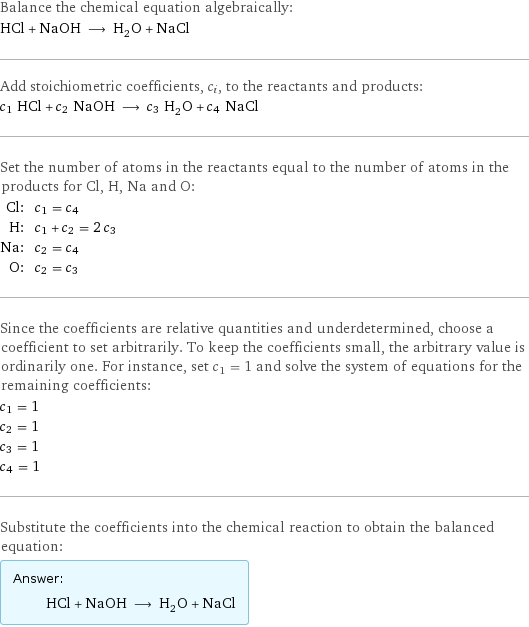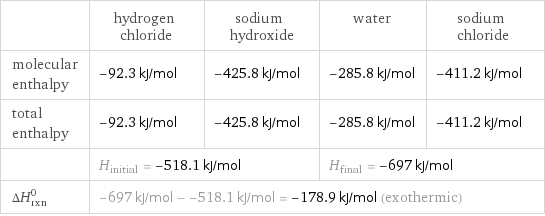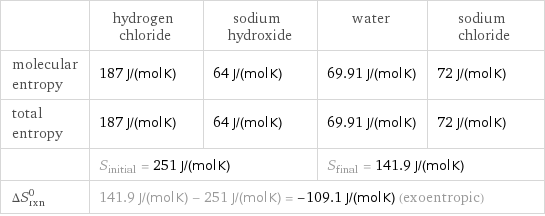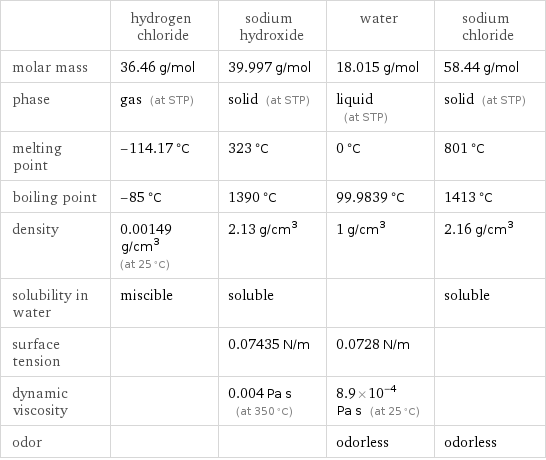Input interpretation

HCl (hydrogen chloride) + NaOH (sodium hydroxide) ⟶ H_2O (water) + NaCl (sodium chloride)
Balanced equation

Balance the chemical equation algebraically: HCl + NaOH ⟶ H_2O + NaCl Add stoichiometric coefficients, c_i, to the reactants and products: c_1 HCl + c_2 NaOH ⟶ c_3 H_2O + c_4 NaCl Set the number of atoms in the reactants equal to the number of atoms in the products for Cl, H, Na and O: Cl: | c_1 = c_4 H: | c_1 + c_2 = 2 c_3 Na: | c_2 = c_4 O: | c_2 = c_3 Since the coefficients are relative quantities and underdetermined, choose a coefficient to set arbitrarily. To keep the coefficients small, the arbitrary value is ordinarily one. For instance, set c_1 = 1 and solve the system of equations for the remaining coefficients: c_1 = 1 c_2 = 1 c_3 = 1 c_4 = 1 Substitute the coefficients into the chemical reaction to obtain the balanced equation: Answer: | | HCl + NaOH ⟶ H_2O + NaCl
Structures

+ ⟶ +
Names

hydrogen chloride + sodium hydroxide ⟶ water + sodium chloride
Reaction thermodynamics
Enthalpy

| hydrogen chloride | sodium hydroxide | water | sodium chloride molecular enthalpy | -92.3 kJ/mol | -425.8 kJ/mol | -285.8 kJ/mol | -411.2 kJ/mol total enthalpy | -92.3 kJ/mol | -425.8 kJ/mol | -285.8 kJ/mol | -411.2 kJ/mol | H_initial = -518.1 kJ/mol | | H_final = -697 kJ/mol | ΔH_rxn^0 | -697 kJ/mol - -518.1 kJ/mol = -178.9 kJ/mol (exothermic) | | |
Gibbs free energy

| hydrogen chloride | sodium hydroxide | water | sodium chloride molecular free energy | -95.3 kJ/mol | -379.7 kJ/mol | -237.1 kJ/mol | -384.1 kJ/mol total free energy | -95.3 kJ/mol | -379.7 kJ/mol | -237.1 kJ/mol | -384.1 kJ/mol | G_initial = -475 kJ/mol | | G_final = -621.2 kJ/mol | ΔG_rxn^0 | -621.2 kJ/mol - -475 kJ/mol = -146.2 kJ/mol (exergonic) | | |
Entropy

| hydrogen chloride | sodium hydroxide | water | sodium chloride molecular entropy | 187 J/(mol K) | 64 J/(mol K) | 69.91 J/(mol K) | 72 J/(mol K) total entropy | 187 J/(mol K) | 64 J/(mol K) | 69.91 J/(mol K) | 72 J/(mol K) | S_initial = 251 J/(mol K) | | S_final = 141.9 J/(mol K) | ΔS_rxn^0 | 141.9 J/(mol K) - 251 J/(mol K) = -109.1 J/(mol K) (exoentropic) | | |
Equilibrium constant
![Construct the equilibrium constant, K, expression for: HCl + NaOH ⟶ H_2O + NaCl Plan: • Balance the chemical equation. • Determine the stoichiometric numbers. • Assemble the activity expression for each chemical species. • Use the activity expressions to build the equilibrium constant expression. Write the balanced chemical equation: HCl + NaOH ⟶ H_2O + NaCl Assign stoichiometric numbers, ν_i, using the stoichiometric coefficients, c_i, from the balanced chemical equation in the following manner: ν_i = -c_i for reactants and ν_i = c_i for products: chemical species | c_i | ν_i HCl | 1 | -1 NaOH | 1 | -1 H_2O | 1 | 1 NaCl | 1 | 1 Assemble the activity expressions accounting for the state of matter and ν_i: chemical species | c_i | ν_i | activity expression HCl | 1 | -1 | ([HCl])^(-1) NaOH | 1 | -1 | ([NaOH])^(-1) H_2O | 1 | 1 | [H2O] NaCl | 1 | 1 | [NaCl] The equilibrium constant symbol in the concentration basis is: K_c Mulitply the activity expressions to arrive at the K_c expression: Answer: | | K_c = ([HCl])^(-1) ([NaOH])^(-1) [H2O] [NaCl] = ([H2O] [NaCl])/([HCl] [NaOH])](../image_source/b9b470b9baf8c64ea9380dc166ee9e0f.png)
Construct the equilibrium constant, K, expression for: HCl + NaOH ⟶ H_2O + NaCl Plan: • Balance the chemical equation. • Determine the stoichiometric numbers. • Assemble the activity expression for each chemical species. • Use the activity expressions to build the equilibrium constant expression. Write the balanced chemical equation: HCl + NaOH ⟶ H_2O + NaCl Assign stoichiometric numbers, ν_i, using the stoichiometric coefficients, c_i, from the balanced chemical equation in the following manner: ν_i = -c_i for reactants and ν_i = c_i for products: chemical species | c_i | ν_i HCl | 1 | -1 NaOH | 1 | -1 H_2O | 1 | 1 NaCl | 1 | 1 Assemble the activity expressions accounting for the state of matter and ν_i: chemical species | c_i | ν_i | activity expression HCl | 1 | -1 | ([HCl])^(-1) NaOH | 1 | -1 | ([NaOH])^(-1) H_2O | 1 | 1 | [H2O] NaCl | 1 | 1 | [NaCl] The equilibrium constant symbol in the concentration basis is: K_c Mulitply the activity expressions to arrive at the K_c expression: Answer: | | K_c = ([HCl])^(-1) ([NaOH])^(-1) [H2O] [NaCl] = ([H2O] [NaCl])/([HCl] [NaOH])
Rate of reaction
![Construct the rate of reaction expression for: HCl + NaOH ⟶ H_2O + NaCl Plan: • Balance the chemical equation. • Determine the stoichiometric numbers. • Assemble the rate term for each chemical species. • Write the rate of reaction expression. Write the balanced chemical equation: HCl + NaOH ⟶ H_2O + NaCl Assign stoichiometric numbers, ν_i, using the stoichiometric coefficients, c_i, from the balanced chemical equation in the following manner: ν_i = -c_i for reactants and ν_i = c_i for products: chemical species | c_i | ν_i HCl | 1 | -1 NaOH | 1 | -1 H_2O | 1 | 1 NaCl | 1 | 1 The rate term for each chemical species, B_i, is 1/ν_i(Δ[B_i])/(Δt) where [B_i] is the amount concentration and t is time: chemical species | c_i | ν_i | rate term HCl | 1 | -1 | -(Δ[HCl])/(Δt) NaOH | 1 | -1 | -(Δ[NaOH])/(Δt) H_2O | 1 | 1 | (Δ[H2O])/(Δt) NaCl | 1 | 1 | (Δ[NaCl])/(Δt) (for infinitesimal rate of change, replace Δ with d) Set the rate terms equal to each other to arrive at the rate expression: Answer: | | rate = -(Δ[HCl])/(Δt) = -(Δ[NaOH])/(Δt) = (Δ[H2O])/(Δt) = (Δ[NaCl])/(Δt) (assuming constant volume and no accumulation of intermediates or side products)](../image_source/5df61e346aa5062eb42ef7e6ffdcaeb4.png)
Construct the rate of reaction expression for: HCl + NaOH ⟶ H_2O + NaCl Plan: • Balance the chemical equation. • Determine the stoichiometric numbers. • Assemble the rate term for each chemical species. • Write the rate of reaction expression. Write the balanced chemical equation: HCl + NaOH ⟶ H_2O + NaCl Assign stoichiometric numbers, ν_i, using the stoichiometric coefficients, c_i, from the balanced chemical equation in the following manner: ν_i = -c_i for reactants and ν_i = c_i for products: chemical species | c_i | ν_i HCl | 1 | -1 NaOH | 1 | -1 H_2O | 1 | 1 NaCl | 1 | 1 The rate term for each chemical species, B_i, is 1/ν_i(Δ[B_i])/(Δt) where [B_i] is the amount concentration and t is time: chemical species | c_i | ν_i | rate term HCl | 1 | -1 | -(Δ[HCl])/(Δt) NaOH | 1 | -1 | -(Δ[NaOH])/(Δt) H_2O | 1 | 1 | (Δ[H2O])/(Δt) NaCl | 1 | 1 | (Δ[NaCl])/(Δt) (for infinitesimal rate of change, replace Δ with d) Set the rate terms equal to each other to arrive at the rate expression: Answer: | | rate = -(Δ[HCl])/(Δt) = -(Δ[NaOH])/(Δt) = (Δ[H2O])/(Δt) = (Δ[NaCl])/(Δt) (assuming constant volume and no accumulation of intermediates or side products)
Chemical names and formulas

| hydrogen chloride | sodium hydroxide | water | sodium chloride formula | HCl | NaOH | H_2O | NaCl Hill formula | ClH | HNaO | H_2O | ClNa name | hydrogen chloride | sodium hydroxide | water | sodium chloride
Substance properties

| hydrogen chloride | sodium hydroxide | water | sodium chloride molar mass | 36.46 g/mol | 39.997 g/mol | 18.015 g/mol | 58.44 g/mol phase | gas (at STP) | solid (at STP) | liquid (at STP) | solid (at STP) melting point | -114.17 °C | 323 °C | 0 °C | 801 °C boiling point | -85 °C | 1390 °C | 99.9839 °C | 1413 °C density | 0.00149 g/cm^3 (at 25 °C) | 2.13 g/cm^3 | 1 g/cm^3 | 2.16 g/cm^3 solubility in water | miscible | soluble | | soluble surface tension | | 0.07435 N/m | 0.0728 N/m | dynamic viscosity | | 0.004 Pa s (at 350 °C) | 8.9×10^-4 Pa s (at 25 °C) | odor | | | odorless | odorless
Units
